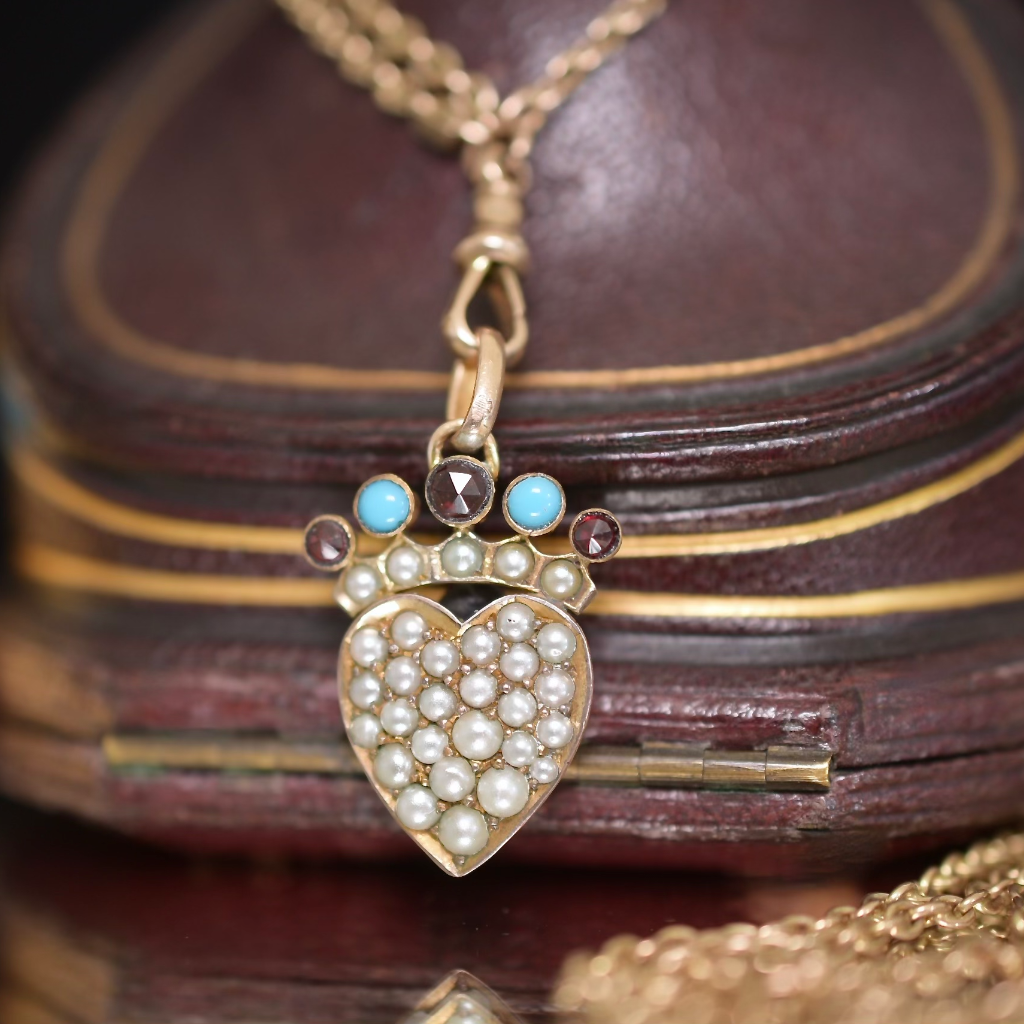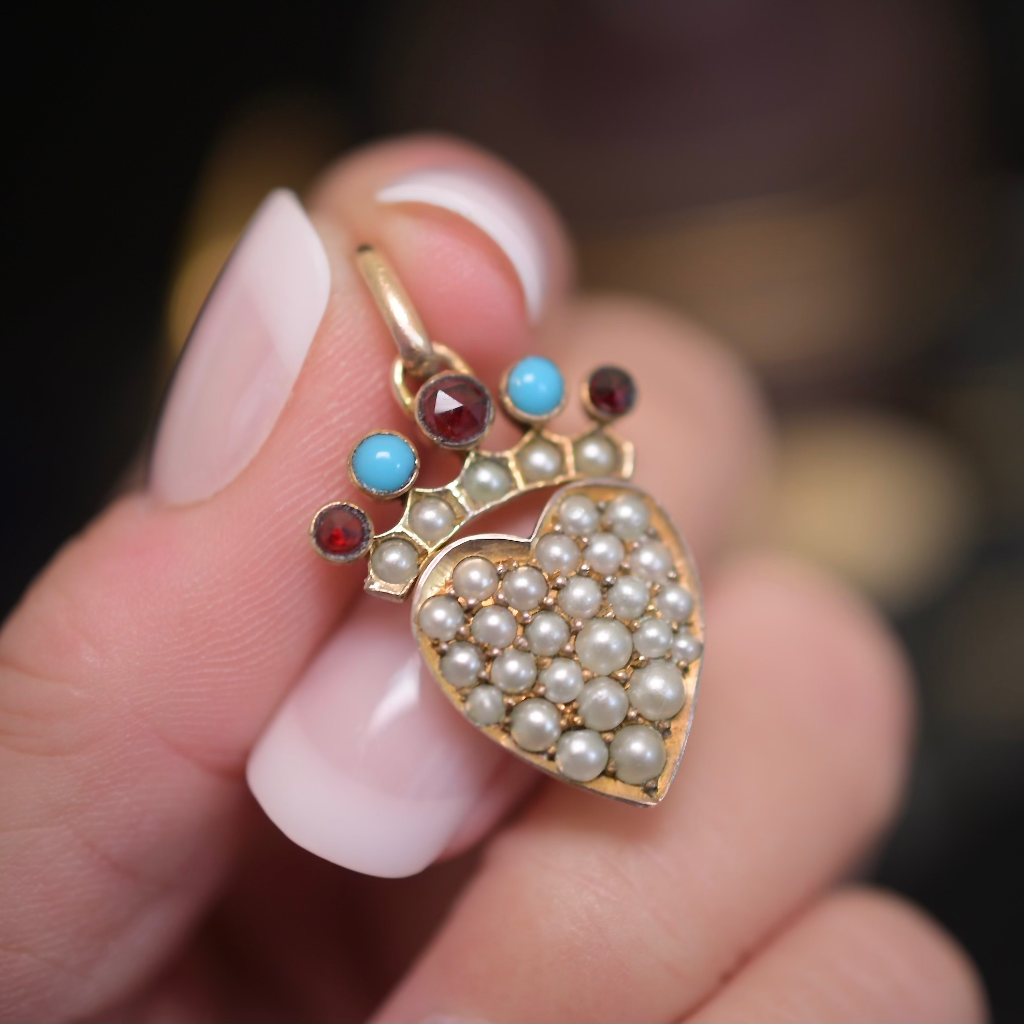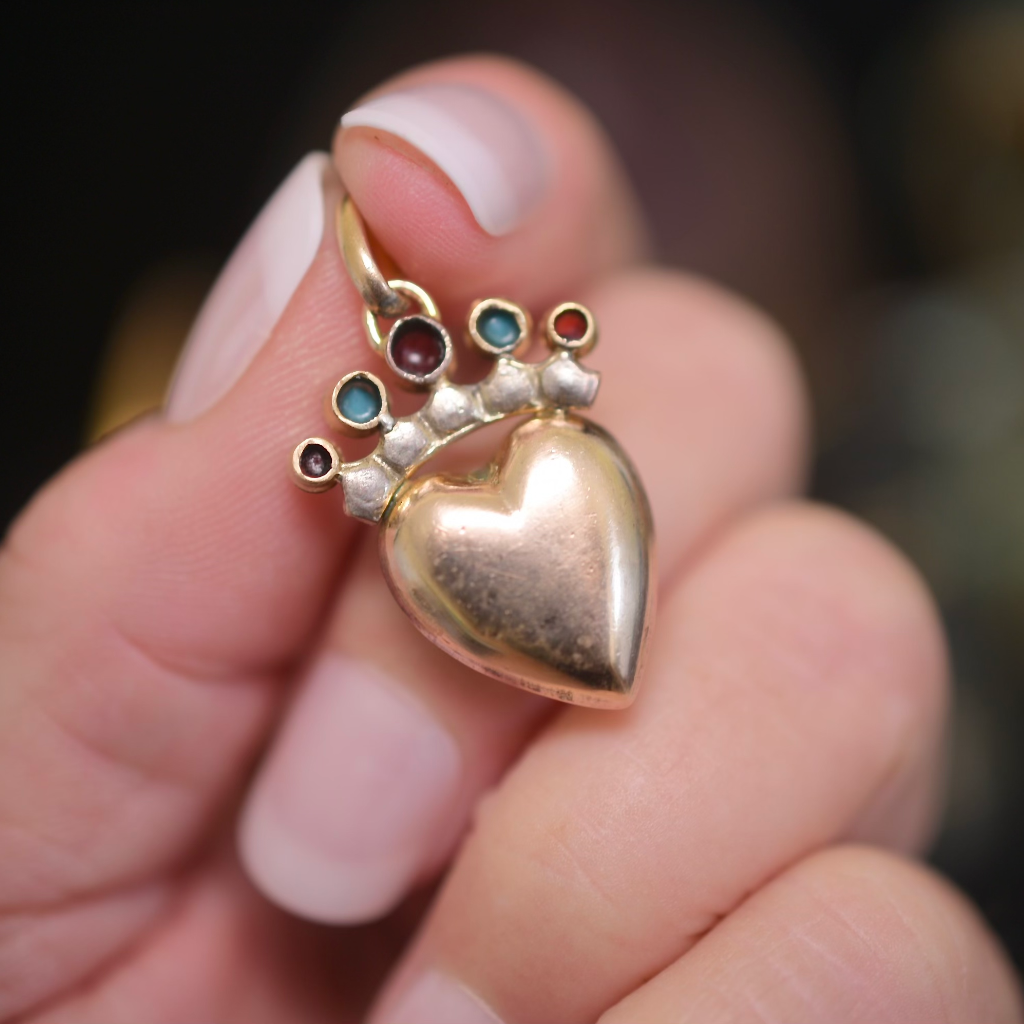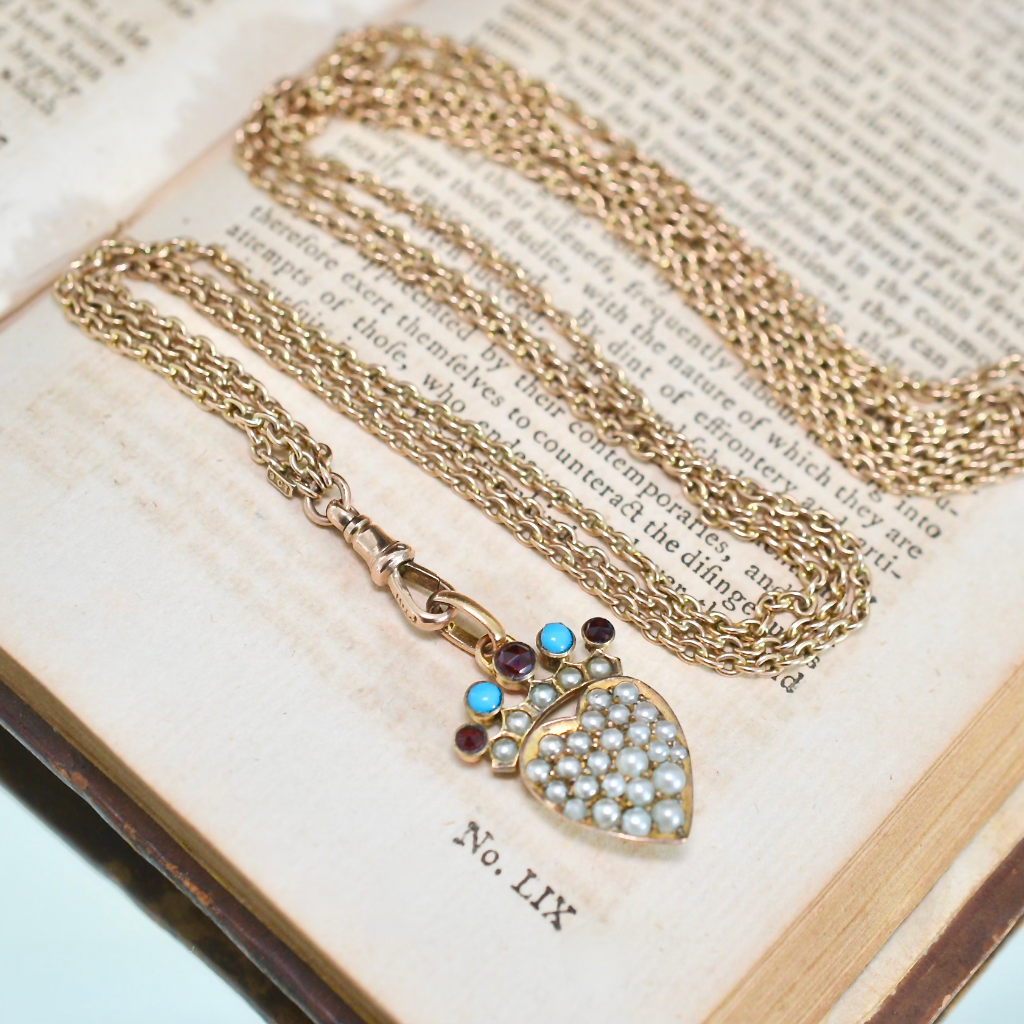




Antique Victorian Gold-Filled Crowned Heart Pendant Circa 1880-90
Please note boxes and chains are for display only unless otherwise stated.
An interesting Victorian piece of symbolic jewellery we believe dates to the late Victorian era but perhaps a little earlier.
Designed as a ‘crowned heart’, this gorgeous piece features an array Turquoise glass cabachons, Bohemian style Garnets (tested) and bright, all original faux half Pearls. Plain to verso (gold filled) with old, silver backing to the row of faux pearls while the backs of gems are fully exposed.
STONES
Faux half Pearls
Turquoise glass cabochons
Bohemian style Garnets (tested)
MEASUREMENTS
3.5cm drop with bale
2cm wide art widest point
WEIGHT
3.48 Grams
MARKS
None
Gold filled or rolled gold
CONDITION
Good antique condition. All faux Pearls are original with no re-glues. At some point in history we believe the turquoise glass and garnets may have been either re-set or replace, hard to tell as they fit well and are secure, under very close x 10 loupe magnification they are subtle signs of resetting, however all secure and look lovely. Minor marks to verso, small very shallow pinpoint dents only. Oval bale is original and sealed, thick and strong. An interesting piece!
The Enduring Symbolism of Heart-Shaped Jewellery in Romantic Love
Heart-shaped jewellery as a symbol of friendship, devotion, affection and of course love and romance, was first reported towards the end of the Middle Ages. Since then, heart-shaped jewellery has remained synonymous in jewellery design for its mulitlayered significance.
Valentine's Day, established in 496 to honour the martyred saint who helped lovers and performed secret marriages, helped promote the heart-shape even further. It gained popularity in the seventeenth century when it involved simple love notes, often adorned with hearts.
The style continued to evolve throughout this period, notably the popular Stuart jewel made to honor Charles I which was the simple crystal heart-shaped locket. The style continued into the next two centuries as a more general token of affection. The locket almost always contained a lock of hair of a loved one. If worn empty, the clear, transparent heart signified truth or purity.
Another popular Georgian style of heart was the simple open heart brooch which were almost always made of garnets, a stone associated with love, and were typically given as tokens of affection, again signifying loyalty - this also extended to the crowned heart style. These brooches were usually quite small and were worn as lace pins, ie to hold in place a piece of lace or fichu.
Some of the different styles included a witch’s heart, with its bottom curved to one side, which was originally worn as an amulet in ancient times to protect against evil eyes and from witches stealing milk or harming newborn babies. In Scottish culture it is called the Luckenbooth heart, and in the 18th century the token implied that the giver had become “bewitched to fall in love” with the recipient.
The History of Faux Pearls: A Cost-Effective Alternative to Natural Pearls
Since ancient times, people have sought a more affordable and readily available alternative to natural pearls. In Ancient Rome, glass beads were coated with silver and then coated again with glass to simulate the luster of pearls. Similarly, small balls of clay coated with mica powder and then baked were another early attempt to create a natural pearl look.
However, it was the man-made 'pearls' that had the most significant impact on the fashion industry. These pearls could be mass-produced, making them more affordable for a broader market. In the 13th century, the Chinese discovered how to cultivate pearls in the shell, but it was the faux pearls that gained popularity. At the beginning of production, the workshops of Murano were the only ones creating such pearls. But by the 19th century, Paris and Rome had become two of the largest centers for bead manufacturing, catering to the pearl-laden fashions of the day.
The middle-class ladies could adorn themselves with Roman pearls, and the wealthy wife of a landowner could wear Parisian pearls as part of her daytime wardrobe, reserving her finest natural pearls for special events.
Two forms of faux pearls were manufactured in Italy. The earliest, dating back to at least the 13th century, were imitation glass pearls produced in the ingenious glass workshops of Venice. These pearls were made from a mixture of powdered glass, snail slime, and egg white, which was molded and then hardened around a bead.
In 1440, a publication revealed the secret of making pearls from shells and fish scales. The Venetian pearl merchants felt so threatened by the trade in fake pearls that they made it illegal to produce them. Violation was punished by the loss of the maker's right hand and a ten-year enforced exile.
Laybys & Hold Policy
Do you have your eye on a fabulous piece but need some extra time to
pay? At Graisons, we offer suitable layby terms for pieces priced $400 AUD and above. Contact us for more details.
Purchase Guide & Refund Policy
For information regarding our Purchase Guide & Returns Policy, please click here
Shipping & Delivery
Free Complimentary Express Shipping: Australia & Select International Countries.
We are pleased to offer free complimentary express postage, fully insured with tracking and signature on delivery using Australia Post.
Orders are dispatched within one-two business days of purchase. Once complete, a tracking number will be forwarded to you via email notification.
We are currently shipping to the following international countries:
UK, USA, CANADA, SINGAPORE, NEW ZEALAND, HONG KONG.
PLEASE NOTE: Any duties imposed by countries for importing our items are the buyers responsibility. Please contact your local customs agency if you wish to discuss potential rates and fees.
Caring For Antique & Vintage Jewellery
We absolutely pride ourselves on sourcing the best quality pieces for our customers, with many of our items valued by our registered jeweller/gemologist.
Our collection consists of pieces that are of antique and vintage condition, which means that all our items are secondhand and used. Customers are not purchasing 'new', 'perfect' and 'unworn items', and as such, should expect wear and imperfection. Any condition issues are always extensively mentioned in the condition summary.
Please do not hesitate to ask questions prior to purchase. It is the responsibility of the purchaser to ensure that these descriptions and pictures are carefully viewed and any questions are asked prior to the transaction taking place.
Please refer to our guide, Caring For Antique & Vintage Jewellery for more details.
Your Purchase: What Is Included?
Your purchase will be lovingly packaged in our custom made, eco-friendly Graisons Fine Jewellery Jewel box tied with ribbon inside our custom made packaging/mailing box.
For added safety and security, all purchases are shipped inside an Australia Post medium sized mailing box.
If your item includes an independent valuation, the physical certificate will be included.
Choose options




